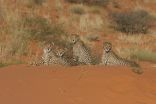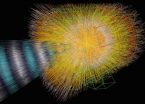(Press-News.org) The HIV pandemic with us today is almost certain to have begun its global spread from Kinshasa, the capital of the Democratic Republic of the Congo (DRC), according to a new study.
An international team, led by Oxford University and University of Leuven scientists, has reconstructed the genetic history of the HIV-1 group M pandemic, the event that saw HIV spread across the African continent and around the world, and concluded that it originated in Kinshasa. The team's analysis suggests that the common ancestor of group M is highly likely to have emerged in Kinshasa around 1920 (with 95% of estimated dates between 1909 and 1930).
HIV is known to have been transmitted from primates and apes to humans at least 13 times but only one of these transmission events has led to a human pandemic. It was only with the event that led to HIV-1 group M that a pandemic occurred, resulting in almost 75 million infections to date. The team's analysis suggests that, between the 1920s and 1950s, a 'perfect storm' of factors, including urban growth, strong railway links during Belgian colonial rule, and changes to the sex trade, combined to see HIV emerge from Kinshasa and spread across the globe.
A report of the research is published in this week's Science.
'Until now most studies have taken a piecemeal approach to HIV's genetic history, looking at particular HIV genomes in particular locations,' said Professor Oliver Pybus of Oxford University's Department of Zoology, a senior author of the paper. 'For the first time we have analysed all the available evidence using the latest phylogeographic techniques, which enable us to statistically estimate where a virus comes from. This means we can say with a high degree of certainty where and when the HIV pandemic originated. It seems a combination of factors in Kinshasa in the early 20th Century created a 'perfect storm' for the emergence of HIV, leading to a generalised epidemic with unstoppable momentum that unrolled across sub-Saharan Africa.'
'Our study required the development of a statistical framework for reconstructing the spread of viruses through space and time from their genome sequences,' said Professor Philippe Lemey of the University of Leuven's Rega Institute, another senior author of the paper. 'Once the pandemic's spatiotemporal origins were clear they could be compared with historical data and it became evident that the early spread of HIV-1 from Kinshasa to other population centres followed predictable patterns.'
One of the factors the team's analysis
suggests was key to the HIV pandemic's origins was the DRC's transport links, in particular its railways, that made Kinshasa one of the best connected of all central African cities.
'Data from colonial archives tells us that by the end of 1940s over one million people were travelling through Kinshasa on the railways each year,' said Dr Nuno Faria of Oxford University's Department of Zoology, first author of the paper. 'Our genetic data tells us that HIV very quickly spread across the Democratic Republic of the Congo (a country the size of Western Europe), travelling with people along railways and waterways to reach Mbuji-Mayi and Lubumbashi in the extreme South and Kisangani in the far North by the end of the 1930s and early 1950s. This helped establishing early secondary foci of HIV-1 transmission in regions that were well connected to southern and eastern African countries. We think it is likely that the social changes around the independence in 1960 saw the virus 'break out' from small groups of infected people to infect the wider population and eventually the world.'
It had been suggested that demographic growth or genetic differences between HIV-1 group M and other strains might be major factors in the establishment of the HIV pandemic. However the team's evidence suggests that, alongside transport, social changes such as the changing behaviour of sex workers, and public health initiatives against other diseases that led to the unsafe use of needles may have contributed to turning HIV into a full-blown epidemic – supporting ideas originally put forward by study co-author Jacques Pepin from the Université de Sherbrooke, Canada.
Professor Oliver Pybus said: 'Our research suggests that following the original animal to human transmission of the virus (probably through the hunting or handling of bush meat) there was only a small 'window' during the Belgian colonial era for this particular strain of HIV to emerge and spread into a pandemic. By the 1960s transport systems, such as the railways, that enabled the virus to spread vast distances were less active, but by that time the seeds of the pandemic were already sown across Africa and beyond.'
The team says that more research is needed to understand the role different social factors may have played in the origins of the HIV pandemic; in particular research on archival specimens to study the origins and evolution of HIV, and research into the relationship between the spread of Hepatitis C and the use of unsafe needles as part of public health initiatives may give further insights into the conditions that helped HIV to spread so widely.
INFORMATION:
HIV pandemic's origins located
Pandemic spread almost certainly began in Democratic Republic of the Congo
2014-10-02
ELSE PRESS RELEASES FROM THIS DATE:
New map exposes previously unseen details of seafloor
2014-10-02
Accessing two previously untapped streams of satellite data, scientists at Scripps Institution of Oceanography at UC San Diego and their colleagues have created a new map of the world's seafloor, creating a much more vivid picture of the structures that make up the deepest, least-explored parts of the ocean. Thousands of previously uncharted mountains rising from the seafloor and new clues about the formation of the continents have emerged through the new map, which is twice as accurate as the previous version produced nearly 20 years ago.
Developed using a scientific ...
New study suggests humans to blame for plummeting numbers of cheetahs
2014-10-02
A new study led by Queen's University Belfast into how cheetahs burn energy suggests that human activity, rather than larger predators, may force them to expend more energy and thus be the major cause of their decline.
Wild cheetahs are down to under 10,000 from 100,000 a century ago with conventional wisdom blaming bigger predators for monopolising available food as their habitat becomes restricted. The traditional thinking has been that cheetahs no longer have sufficient access to prey to fuel their enormous energy output when engaging in super-fast chases.
But, ...
New approach to boosting biofuel production
2014-10-02
CAMBRIDGE, MA -- Yeast are commonly used to transform corn and other plant materials into biofuels such as ethanol. However, large concentrations of ethanol can be toxic to yeast, which has limited the production capacity of many yeast strains used in industry.
"Toxicity is probably the single most important problem in cost-effective biofuels production," says Gregory Stephanopoulos, the Willard Henry Dow Professor of Chemical Engineering at MIT.
Now Stephanopoulos and colleagues at MIT and the Whitehead Institute for Biomedical Research have identified a new way to ...
Falling asleep: Revealing the point of transition
2014-10-02
How can we tell when someone has fallen asleep? To answer this question, scientists at Massachusetts General Hospital have developed a new statistical method and behavioural task to track the dynamic process of falling asleep.
Dr Michael Prerau, Dr Patrick Purdon, and their colleagues used the evolution of brain activity, behaviour, and other physiological signals during the sleep onset process to automatically track the continuous changes in wakefulness experienced as a subject falls asleep.
The study, publishing today in PLOS Computational Biology, suggests that it ...
Researchers identify new pathway linking the brain to high blood pressure
2014-10-02
VIDEO:
Dr. Frans Leenen, from the University of Ottawa Heart Institute, discusses the importance of these new findings.
Click here for more information.
Ottawa, ON and Baltimore, MD, October 2, 2014—New research by scientists at the Ottawa Heart Institute and the University of Maryland School of Medicine (UM SOM) has uncovered a new pathway by which the brain uses an unusual steroid to control blood pressure. The study, which also suggests new approaches for treating high blood ...
York academics reveal new findings about insect diversification
2014-10-02
Biologists from the University of York have compiled two new datasets on insect evolution, revealing that metamorphosing insects diversify more quickly than other insects and are therefore the biggest contributors to the evolution of insect diversity.
Both funded by the Natural Environment Research Council (NERC), the first dataset is a complete fossil catalogue showing timescales of origination and extinction of different families of insects. Working with the Natural History Museum and National Museums Scotland, former PhD student Dr David Nicholson collated a database ...
A closer look at the perfect fluid
2014-10-02
By combining data from two high-energy accelerators, nuclear scientists have refined the measurement of a remarkable property of exotic matter known as quark-gluon plasma. The findings reveal new aspects of the ultra-hot, "perfect fluid" that give clues to the state of the young universe just microseconds after the big bang.
The multi-institutional team known as the JET Collaboration, led by researchers at the U.S. Department of Energy's Lawrence Berkeley National Lab (Berkeley Lab), published their results in a recent issue of Physical Review C. The JET Collaboration ...
Supreme delay: Why the nation's highest court puts off big decisions until the last moment
2014-10-02
As the Supreme Court of the United States begins its fall 2014 session this month, it faces decisions on several "blockbuster" cases, including freedom of speech, religious freedoms in prison, pregnancy discrimination and a possible decision on gay marriage.
Just don't expect any of these decisions until next June, just before the court's session ends.
New research from the Washington University in St. Louis School of Law finds big, or "blockbuster," cases are disproportionately decided at the end of June, just before the court's summer recess.
"We knew that more than ...
Washington University review identifies factors associated with childhood brain tumors
2014-10-02
Older parents, birth defects, maternal nutrition and childhood exposure to CT scans and pesticides are increasingly being associated with brain tumors in children, according to new research from the Brown School at Washington University in St. Louis.
Brain and central nervous system tumors are the second leading cause of cancer death in children.
A team of researchers, led by Kimberly Johnson, PhD, assistant professor of social work at the Brown School, a member of the Institute for Public Health and a research member of Siteman Cancer Center, examined studies published ...
Quantum environmentalism
2014-10-02
Where are the quantum computers? Aren't they supposed to be speeding up decryption and internet searches? After two decades of research, you still can't find them in stores. Well, it took two decades or more of research dedicated to semiconductors and circuit integration before we had digital computers. For quantum computers too it will take technology more time to catch up to the science
Meanwhile, research devoted to exploring bizarre quantum phenomena must continue to overcome or reduce a litany of practical obstacles before quantum computing can be realized. ...
LAST 30 PRESS RELEASES:
Satellite communication systems: the future of 5G/6G connectivity
Space computing power networks: a new frontier for satellite technologies
Experiments advance potential of protein that makes hydrogen sulfide as a therapeutic target for Alzheimer’s disease
Examining private equity’s role in fertility care
Current Molecular Pharmacology achieves a landmark: real-time CiteScore advances to 7.2
Skeletal muscle epigenetic clocks developed using postmortem tissue from an Asian population
Estimating unemployment rates with social media data
Climate policies can backfire by eroding “green” values, study finds
Too much screen time too soon? A*STAR study links infant screen exposure to brain changes and teen anxiety
Global psychiatry mourns Professor Dan Stein, visionary who transformed mental health science across Africa and beyond
KIST develops eco-friendly palladium recovery technology to safeguard resource security
Statins significantly reduce mortality risk for adults with diabetes, regardless of cardiovascular risk
Brain immune cells may drive more damage in females than males with Alzheimer’s
Evidence-based recommendations empower clinicians to manage epilepsy in pregnancy
Fungus turns bark beetles’ defenses against them
There are new antivirals being tested for herpesviruses. Scientists now know how they work
CDI scientist, colleagues author review of global burden of fungus Candida auris
How does stroke influence speech comprehension?
B cells transiently unlock their plasticity, risking lymphoma development
Advanced AI dodel predicts spoken language outcomes in deaf children after cochlear implants
Multimodal imaging-based cerebral blood flow prediction model development in simulated microgravity
Accelerated streaming subgraph matching framework is faster, more robust, and scalable
Gestational diabetes rose every year in the US since 2016
OHSU researchers find breast cancer drug boosts leukemia treatment
Fear and medical misinformation regarding risk of progression or recurrence among patients with breast cancer
Glucagonlike peptide-1 receptor agonists and asthma risk in adolescents with obesity
Reviving dormant immunity: Millimeter waves reprogram the immunosuppressive microenvironment to potentiate immunotherapy without obvious side effects
Safety decision-making for autonomous vehicles integrating passenger physiological states by fNIRS
Fires could emit more air pollution than previously estimated
A new way to map how cells choose their fate
[Press-News.org] HIV pandemic's origins locatedPandemic spread almost certainly began in Democratic Republic of the Congo




